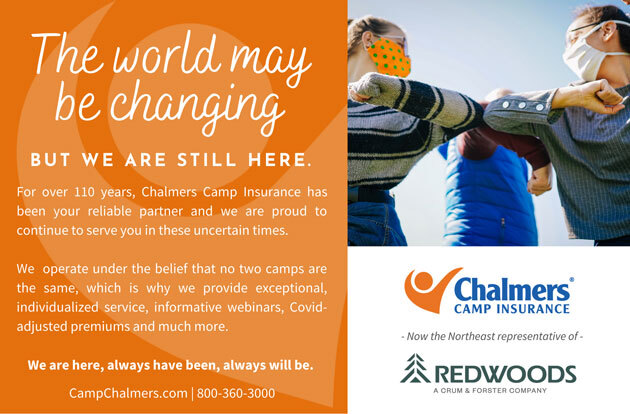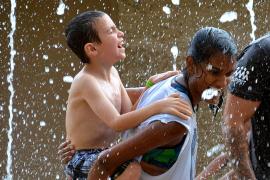Summer camps provide children an opportunity for goal achievement, a sense of community, and development of self-concept. Toward that end, goal-directed camp activities revolve around teamwork, as well as improving coping skills and fostering intimate relationships (Carlson & Cook, 2007). However, campers may have cognitive-behavioral concerns — an inability to attend to activities, for example, or impulsiveness, decreased ability to cope with environmental demands such as sound, light, and tactile sensations, and decreased social awareness. All such challenges can impact their ability to fully participate in camp activities. Youth with cognitive behavioral symptoms as well as physical limitations may have difficulty adapting to the camp environment and developing peer relationships. This may result in social isolation and/or targeting for victimization (Cordier et al., 2018; Kaboski et al., 2014; Wong, 2018).
Camp Counselor Role in Inclusion and Participation
Camp counselors play a significant role in promoting camper participation and inclusion through activities with the goal of building youth confidence through forming supportive relationships with campers during the camp period (Povilaitis & Tamminen, 2018; Taniguchi et al., 2007). Positive outcomes emerge through such counselor/youth bonds as:
- Enhanced self-esteem
- A sense of identity
- Increased social skills
- Increased responsibility for both camper and counselor (Halsall et al., 2016)
In addition, camp counselors help support youth in specific skill development (such as sports and crafts) and facilitate personal growth through leadership and peer interaction. Researchers Victoria Povilaitis and Katherine Tamminen (2018) found that campers experienced both physical and psychosocial well-being when camp counselors asserted responsibility for their campers’ participation. Those who created an environment that was both welcoming and inviting also increased campers’ feelings of safety. The study also found that when counselors tailored activities to the group’s abilities and needs, youth were more engaged in the tasks, finding it easier to connect with their peers (Povilaitis & Tamminen, 2018).
Camp counselors who work directly with campers are typically between the ages of 15 and 21, with the youngest of these individuals spending the most time with their campers (Halsall et al., 2016; Taniguchi et al., 2007). Depending on their prior camp experience, temperament, skill level, and social aptitude, camp counselors may find it difficult to connect with every camper. However, training on disability, inclusion, and adaptive participation promotes their own development as well as the campers’ (Halsall et al., 2016). While counselor training often includes cardio-pulmonary resuscitation (CPR), first aid and safety, and use of camping equipment, social-emotional training and inclusion/participation initiatives are less common despite their benefits for both the counselor and campers.
Camp Counselor Training
Forty-two Treasure Valley Scout Reservation camp counselors participated in an eight-hour training program developed and led by two Master of Occupational Therapy students and their supervisor for a community health class. Occupational therapy (OT) is a healthcare profession that works with people across the lifespan to promote health, wellness, and participation. OTs are trained in both neurological and mental health concerns, enabling them to adapt activities and environments to promote inclusion and participation for those with disabilities.
At the start of this program, a needs assessment was completed with the camp director to establish areas of concern. Those that emerged were camper participation, transitions between areas, and staff understanding of cognitive/behavioral concerns. As a result, a training program was developed to assist counselors to facilitate inclusion and participation of campers who were unable to follow the camp routine, structure, and activities. The camp counselor training consisted of three sessions. Two training sessions were held prior to camper arrival during the camp’s regularly scheduled staff training week; the third session took place after camper participation, in order to reflect on the results of the program. During that third session, counselors reported observations of sensory behaviors exhibited by campers during the previous weeks. The authors then led a counselor reflection on the interventions used by camp staff and provided staff with additional strategies to help facilitate camper participation.
The initial training consisted of a two-hour session focused on how to manage camper behavior and social isolation. It began as an interactive question-and-answer session to gauge the staff’s prior experience working with youth with cognitive/behavioral conditions. Shortly after reflection, the staff were given a quantitative pretest survey developed by the authors titled “Test Your Knowledge.” Once completed, the lecture began with an overview of diagnoses and the symptoms that might be associated with cognitive/behavior concerns. Developmental milestones for the preadolescent period were also reviewed, including the needs of:
- Independence
- Expression of autonomy
- Self-advocacy
- Acceptance of responsibility (Case-Smith & O’Brien, 2015)
With these concepts as a foundation, session instruction continued with discussion of sensory processing. This involves the way children and adults process information through their five senses, including the unconventionally known proprioceptive, interoceptive, and vestibular movement senses (Dunn, 2007). Sensory-processing behaviors were categorized into three types: sensory seeking, hypersensitivity (sensory avoiding), and hyposensitive (sensory unresponsive) (Dunn, 2007). Role-playing of the sensory types by the instructors and verbal examples helped to solidify the concepts for the counselors.
With a new understanding of the behavior exhibited by campers with cognitive/behavioral symptoms, the staff was asked to identify concerns in the camp environment for each type of sensory-processing behavior. For example, a sensory-seeking camper may be very rough with tools, or a hypersensitive camper may run away to a quiet location if an environment is too loud or busy. A discussion on environmental and activity adaptations followed the identification of sensory-processing behaviors. This information specifically focused on how the counselors could embed these strategies into their program areas, such as utilizing sensory breaks while playing a group game to increase social participation or self-regulation for a hypersensitive camper. Additional training on the use of a sensory space for quiet time and sensory bags to allow for calming activities was also implemented to offer additional strategies for self-regulation. The sensory bags included:
- A weighted stuffed animal
- A Rubik’s Cube
- A weighted vest
- A frisbee
- Stress balls
- Other fidget toys
The goal of these coping strategies was to increase time spent in program activities while promoting social inclusion with peers.
The second training session was completed the next day and consisted of individualized trainings for each of the nine program areas, utilizing an environmental checklist. A review of each area’s specific environmental checklist was conducted and explained using role-playing exercises performed by the camp counselors and facilitated by the authors. The environmental checklists were composed of three sections labeled with each of the three sensory-processing types. Below each processing type was a list of example behaviors that would be exhibited should certain environmental stimuli be present. For example, noise and smell in the woodworking environment might cause a hypersensitive camper to withdraw from an activity, but the same stimuli might engage a hyposensitive camper.
The last training session took place two weeks later after campers were in attendance. The authors conducted an educational discussion with the counselors to review the behaviors the counselors had observed and which interventions facilitated participation. In this session the authors were able to clarify and answer any questions about camper inclusion and counselor role competence. In addition, counselors were given a quantitative posttest survey to gauge learning and use of techniques taught during training.
Results
The quantitative results of the survey revealed that prior to training, the majority of counselors had worked with children who may not have made eye contact or interacted with others, sat alone during activities, and who may have become overwhelmed by the environment. Thirty-three percent of counselors reported having a moderate amount of training prior to the program. After the eight-hour program, 65 percent of camp counselors expressed receiving a moderate amount of training in working with children with cognitive/behavioral symptoms. Counselors having heard of sensory processing increased from 19 percent to 87.5 percent. Approximately 5 percent of camp counselors were aware of the scientific terms to describe sensory processing before the training program. Posttest results, however, revealed an 85-percent response rate to the understanding of the three types of sensory processing.
After the training program counselors expressed an increase in experience when working with children with cognitive behavioral symptoms. Increased experience supported counselors’ new learning. Prior to the training program, many of the counselors stated that they were unfamiliar with strategies needed to facilitate self-regulation. Answers to the pretest scenario questions indicated that 23.8 percent of counselors would have gone to the area director to solve an issue. After the training, this diminished to only 7.5 percent. The posttest revealed that more of the respondents (82.5 percent) chose to facilitate engagement by having the isolated camper sit next to them when compared to the pretest (66.7 percent). Increased knowledge of strategies and better understanding of cognitive/behavioral symptoms promoted confidence and comfort in the counselor role, as demonstrated by the 17-percent increase in comfort and the 55.9-percent increase in confidence between the pre- and posttest inquiries.
No significant change was demonstrated in the posttest regarding the counselors’ abilities to facilitate scouts’ (with cognitive/ behavioral concerns) merit badge attainment. However, a majority of counselors reported an increase in camper independent participation after the training program — from 0 percent–25 percent at the pretest to 25 percent–50 percent at the posttest. This result is consistent with the results Povilaitis and Tamminen (2018) found when the counselors tailored activities to the group’s abilities and needs, leading to positive outcomes. The camp counselors demonstrated their ability to assist campers by describing the modifications they had made to the environment and adaptations made to activities to improve sensory regulation. Adaptations included the use of the sensory bag, providing fidget toys during activities, use of the weighted stuffed animal for focus, asking campers to perform heavy work tasks for regulation, going for walks, and playing games in between activities to continue engagement and participation. The camp counselors engaged and supported campers who had struggled in activity sessions utilizing the knowledge, support, and confidence gained through the program. In addition to modeling, recreational activity, and common interest, the counselors demonstrated reduced anxiety in working with children with cognitive/behavioral symptoms. This assisted in the well-being and confidence of both the counselor and campers.
Fort et al. (2016) demonstrated that typically developing adolescents changed their attitudes toward those with disabilities to develop meaningful relationships through competence in adapting activities and empathy. Through the training program, the counselors in this study assisted in the cultivation of positive camper interactions and a change in understanding of the behaviors campers exhibit.
Conclusion
Camp counselors are often inexperienced adolescents who do not have adequate training to work with children with cognitive-behavioral concerns. This may contribute to negative experiences in the camp setting for both the dysregulated camper and camp counselor (Povilaitis & Tamminen, 2018; Taniguchi et al., 2007; Wong et al., 2018). Comparing pretest and posttest results, the eight-hour training program was beneficial to the counselors at the overnight camp. The program’s findings emphasize the need for camp counselor training programs when working with campers with cognitive/behavioral dysregulation. Not only would counselor training help campers with cognitive/behavioral concerns, but it could also assist the general camp population, as counselors would role model empathy, understanding, and inclusion. Adolescent and young adult counselors made significant improvements in learning sensory-processing terms and definitions. The counselors gained confidence when adapting the camp activities and program environments, ultimately decreasing the behavioral concerns of some campers. This promoted both counselor confidence and camper participation, supporting a positive camping experience for everyone involved.
Photo courtesy of Camp Conquest, Millington, TN.
Christopher V.B. Lazzaro MOT, OTR/L, is a registered occupational therapist and former graduate student from Worcester State University. He is also an Eagle Scout, having been involved with scouting and his local summer camp for several years, participating as a camper, camp counselor, and camp commissioner, administrating the Cub Scout Camp. Chris continues to be involved in scouting, assisting with the development of merit badge fairs, and assisting at district events. His professional objective is to implement approaches in summer camp and academic settings to promote the participation and inclusion of children in desired activities.
Cheryl Lucas, EdD, has been an occupational therapist for over 35 years with a focus on leisure and quality of life of clients throughout the life span. She has been in academia for the past eight years and is currently an associate professor at Quinnipiac University.
Kelly Myrto, MOT, OTR, is a former graduate student from Worcester State University’s Occupational Therapy Program. She has taught skiing in the group setting for young children for about 10 years now. Through this experience she has seen how children interact with each other and the environment around them. Kelly has also volunteered with Partner’s Club, Special Olympics, and Best Buddies, which has inspired her to pursue a career in occupational therapy. Kelly has always enjoyed working with children in all different types of environments and activities.
Treasure Valley Scout Reservation is a 1600-acre summer camp and protected wilderness area in Rutland, Massachusetts, offering programs to children (boys and girls) ages 5–17. Additional programs offer day and overnight experiences for families focusing on leadership and group development.
References
The American Occupational Therapy Association. (2018). AOTA board expands vision 2025. American Journal of Occupational Therapy, 73. doi.org/10.73034200107303420010
Carlson, K.P., & Cook, M. (2007). Challenge by choice: Adventure-based counseling for seriously ill adolescents. Child and Adolescent Psychiatric Clinics of North America, 16(4), 909-919. doi.org/10. 1016/j.chc.2007.05.002
Case-Smith, J., & O’ Brien, J. C. (2015). Adolescent development: Transitioning from child to adult. In J. Case-Smith & J.C. Obrien (Ed.), Occupational therapy for children and adolescents (7th ed., 102-124). Elsevier.
Cordier, R., Vilaysack, B., Doma, K., Wilkes-Gillan, S., & Speyer, K. (2018). Peer inclusion in interventions for children with ADHD: A systematic review and meta-analysis. BioMed Research International, 1-53. doi.org/10.1155/2018/7693479
Dunn, W. (2007). Supporting children to participate successfully in everyday life by using sensory processing knowledge. Infants & Young Children, 20(2), 84-101. doi.org/10.1097/01.IYC.0000264477.05076.5d
Fort, M., Lundberg, N., Zabriskie, R., Eggett, D., Prater, M.A., & Barney, K. (2017). Adolescents summer camp volunteers’ attitudes toward peers with disabilities. Leisure Sciences, 39(3), 277-249. doi.org/10.1080/01490400.2016.1171740
Halsall, T., Kendellen, K., Bean, C. N., & Forneris, T. (2016). Facilitating positive youth development through residential camp: Exploring perceived characteristics of effective camp counselors and strategies for youth engagement. Journal of Park and Recreation Administration, 34(4), 20-35. doi.org/10.18666/JPRA-2016-V34-I4-7273.
Kaboski, J. R., Diehl, J. J., Beriont, J., Crowell, C. R., Villano, M., Weir, K., & Tang, K. (2014). Brief report: A pilot summer robotics camp to reduce social anxiety and improve social/vocational skills in adolescents with ASD. Journal of Autism and Developmental Disorders, 45(12), 3862-3869. doi.org/10.1007/s10803-014-2153-3
Kang, K. D., Choi, J. W., Kang, S. G., & Han, D. H. (2011). Sports therapy for attention, cognitions and sociality. International Journal of Sports Medicine, 32(12), 953-959. doi.org/10.1055/s-0031-1283175
Merriam, S. B., & Tisdell, E. J. (2016). Qualitative data analysis. Qualitative research: A guide to design and implementation (4th ed., pp. 195-236). Jossey-Bass.
Povilaitis, V., & Tamminen, K. A. (2017). Delivering positive youth development at a residential summer sport camp. Journal of Adolescent Research, 33(4), 470–495. doi.org/10.117/0743558417702478
Taniguchi, S. T., Widmer, M., & Duerden M. (2007). The attributes of effective camp counselors: Changing youths' perspectives of being “cool”. Journal of Experiential Education, 29(3), 378-381. doi.org/10.1177/105382590702900310
Wong, I. Y. T., Hawes, D. J., Clarke, S., Kohn, M. R., & Dar-Nimrod, I. (2018). Perceptions of those with ADHD among diagnosed children and their parents: A systematic review using the common-sense model of illness representations. Clinical Child and Family Psychology Review, 21, 57-93. doi.org/10.1007/s10567-017-0245-2



